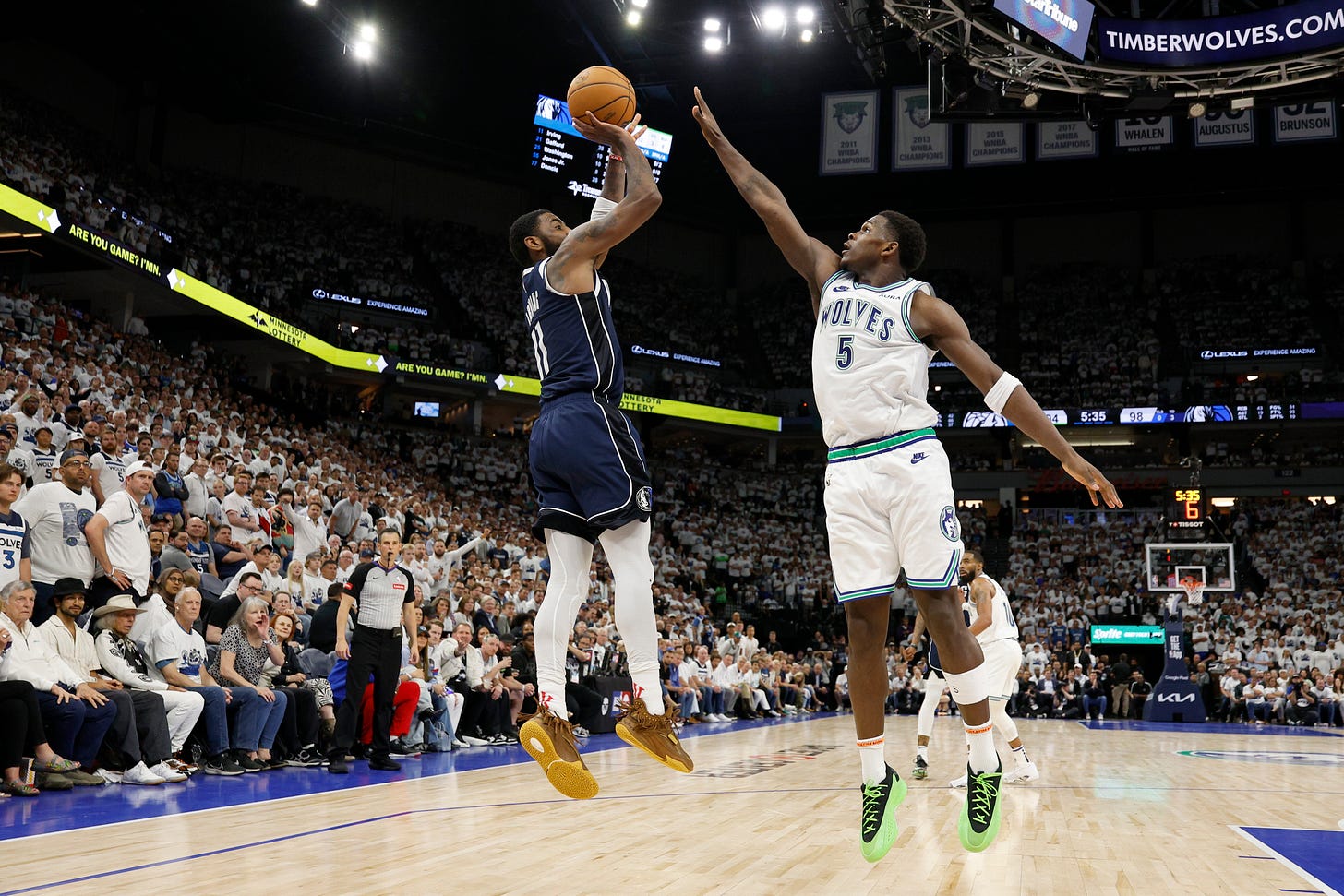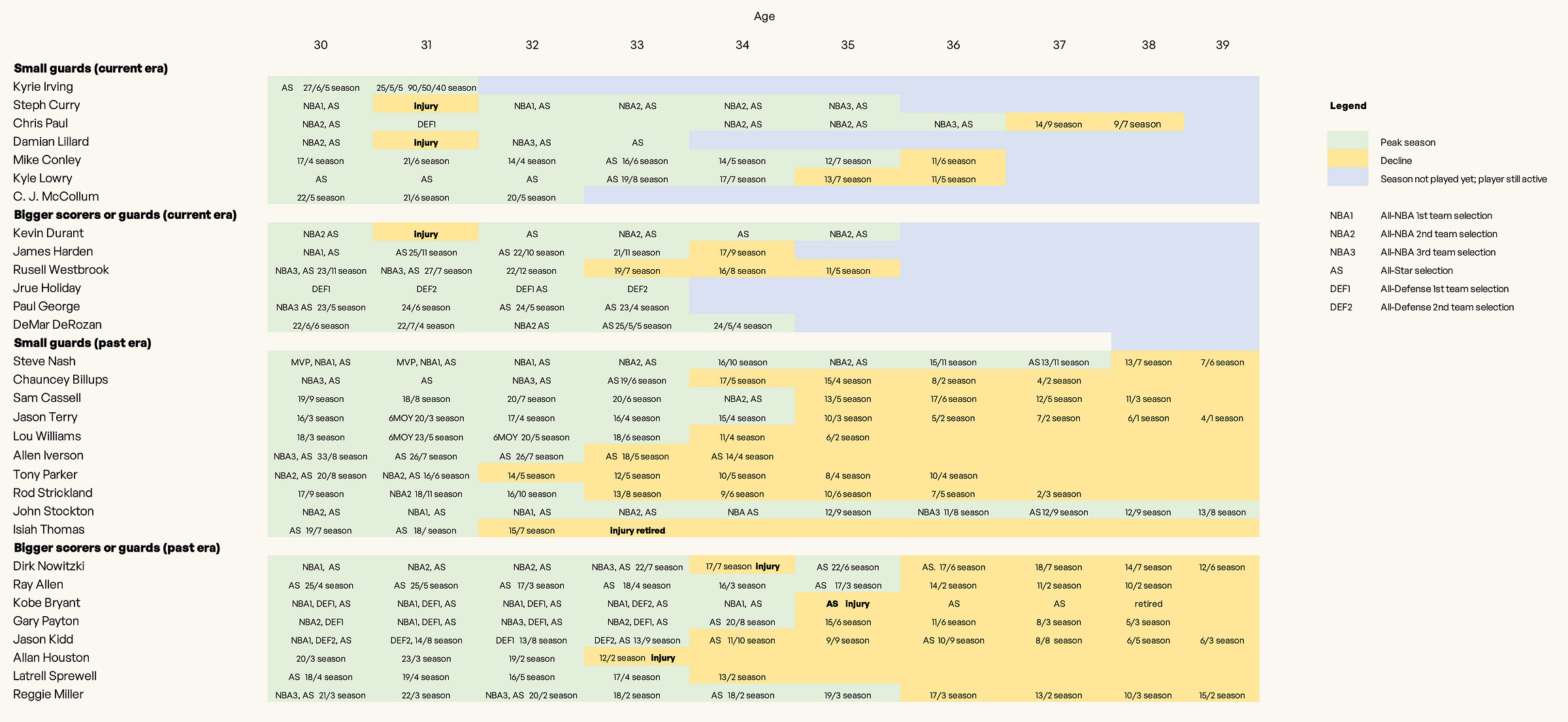‘Not all those who wander are lost.’ ― J.R.R. Tolkien, The Fellowship of the Ring
This was supposed to be a Kyrie Irving 2024-25 Player Card article. Same style and structure as all the others I’ve done over the past few weeks. I had most of it done, but the more I thought about it, the deeper I got, the clearer it became that the 'Key question' is the only part from that format that truly matters. That's how it turned into this analysis. And this is the beauty of this Substack: I don’t have to stick to a pre-defined format or topic if the analysis takes me somewhere else.
The key question, of course, was this: After an incredible season where he cleared all doubts and quieted skeptics—and there were plenty of both—how many more can we expect from Irving, who will turn 33 on March 23rd next year?
But before we get there, let's take a moment to reflect on last season, because the excellence and excitement we witnessed watching Irving in his first full season in Dallas is not something one can take for granted.
It was a season filled with Irving's scoring explosions in fourth quarters. Countless takeovers, with Irving and Dončić knocking out opponents by throwing punches in waves. A 20-foot left-handed floater over Nikola Jokić at the buzzer to seal the win against Denver. An incredible first-round series against the Clippers where Irving might have been the best player on the floor. A playoff run that proved Irving can step up defensively by slowing down James Harden and Jalen Williams, and that it's possible to build a competent, even great defense around him and Dončić. A series against the Timberwolves that showed that even the best defense in the NBA is hopeless when the Mavericks' star duo is at the top of their game. And a season in which Irving, portrayed by some as a chaos agent, became an unquestionable locker room leader.
An elite scorer and shooter
After years of searching for the ideal partner to pair with Dončić, the Mavericks finally found one. Calling him a sidekick would be disrespectful to a player of Irving's caliber; he is a star and was the most efficient high-scoring second option in the NBA last season, depending on how you view the Kevin Durant and Devin Booker dynamic in Phoenix, where both players averaged 27.1 points per game. Irving averaged 25.6 points per game on elite efficiency: he shot 91 percent from the free-throw line, 55 percent from two-point range, and 41 percent from three-point range, placing him alongside Steph Curry as the only two players in the elite 25-point, 90-50-40 club last season.
Curry, Durant, and Irving are, in fact, the only players in the last 25 years to accomplish this feat. Curry has done it six times, Irving four, and Durant twice.
If we include at least five assists and five rebounds per game (both of which Irving achieved last season) in the criteria, the list narrows down to just seven seasons: five by Curry, one by Durant, and last season by Irving.
Two other familiar names for Mavericks fans came close to these levels. During the 2006-07 season, when he won the MVP award, Dirk Nowitzki missed it by a hair, averaging 24.6 points per game on 90/50/40 splits and nearly reaching these benchmarks on a few other occasions (without the assists). The other is Steve Nash, who was always more of a playmaker than a scorer, but had four seasons with at least 15 points and 10 assists while maintaining 90/50/40 efficiency.
Why are these 90/50/40 club comparisons so intriguing?
Because reaching these levels is the mark of elite shooters, and shooting prowess adds a lot of context to my initial question about career longevity.
30 for 30 comparison: 30 players and career arcs after age 30
Based on the above, Curry, Durant, Nash, and Nowitzki were four obvious choices to examine for clues about how long Irving's top-level production might last. But I wanted a larger sample size, because for some reason, I've always had skepticism about smaller guards and their ability to play at a high level once they get past their thirties. It’s also why I was among the skeptics when the Mavericks traded for Irving, a 6-foot-2 guard with past injury concerns last February. Even after Irving's last season, which was so awesome to watch, I found myself, like more pessimistic Mavericks fans, wondering, "Can we get more nice things?"
So, to expand the pool of players for comparison, I ran a similarity analysis algorithm (MDS, or Multidimensional scaling to be exact) to find player-seasons comparable to Irving's most recent one, based on age above 30, scoring and assist rates, and shooting splits. Here’s what the results showed, revealing plenty of interesting names to add to our comparison.
There were a few criteria for selecting the final list of 30 players whose career arcs after age 30 I compared to Irving. My primary focus was on smaller guards from both current and past NBA eras. The second group of players included either bigger guards who stood out in the similarity analysis or taller front-court players who are great shooters like Durant, Nowitzki, or Paul George. All players in the analysis had to have at least a couple of high-level seasons in their thirties, which is why players who suffered major injuries before that age, like Kemba Walker or John Wall, were excluded.
The first pattern that stands out is that all players who extended their high-level years well into their mid-thirties—like Curry, Durant, Chris Paul, Nash, John Stockton, Ray Allen, Nowitzki, and Reggie Miller—were elite shooters. Similarly, players who were a notch (or a couple of notches) below but still had prolonged prime years, such as Mike Conley, Kyle Lowry, DeMar DeRozan, Chauncey Billups, Sam Cassell, Jason Terry, and Lou Williams, made their mark with shooting, skills, or high basketball IQ rather than speed or athleticism. Career arcs of players who relied on the latter two—athleticism and speed—like Allen Iverson, Russell Westbrook, and even Tony Parker to an extent, trended downward earlier once injuries hit or their physical decline began.
A lighter load playing next to Dončić
Doing this exercise made me rethink my perspective on the aging curve of smaller NBA guards. The vast majority of those in my comparison performed at a very high level in their age 32 and 33 seasons—some even well beyond that. This is the territory we’re entering with Irving, and if he can stay clear of serious injuries, Mavericks fans are likely in for at least another one or two years of Irving playing at a superstar level.
Injuries are a concern with Irving, who has dealt with several nagging ones during his short tenure as a Maverick, including the most recent when he broke his left hand during an offseason workout, requiring surgery in July. Irving hasn't played more than 60 games in a season in seven years, and there shouldn't be an expectation for him to do so in the near future. But with last season's trade deadline reshuffle and the summer additions of Klay Thompson, Naji Marshall, and Quentin Grimes, the Mavericks are much better equipped to handle Irving's absence for 20 to 30 games than they were in the first part of last season when Dončić had to carry an excessive load, and the team struggled to stay afloat, playing .500 basketball.
Despite some concerns, Irving thrived in an offense centered around Dončić. This setup allowed him to pace himself during games, playing off the ball and converting on the looks Dončić created early, then taking over as the primary ball handler in the closing moments. Per Cleaning the Glass, Irving was assisted on almost half of his made shots last season—46 percent, a big jump from his previous career high of 37 percent. Furthermore, 203 of Irving's 421 three-point attempts were catch-and-shoot shots, and he made 43 percent of them. He also attempted 84 corner threes last season, his highest mark since 2016-17, converting at an impressive 49 percent. All these stats are a testament to Irving's elite shooting and the fact that, within the Mavericks' offense, he's getting plenty of opportunities that don't require him to dribble or drive on every possession to score.
The luxury—and his ability—of playing more as a finisher than a playmaker next to Dončić bodes well for Irving's longevity. Irving looked as spry as ever last season, recording a career-high six dunks, including two highlight-reel alley-oops—the first two of his career, according to Second Spectrum tracking data.
The addition of Thompson, another excellent play finisher, should give Irving even more room to pick his spots during games next season. It will also provide Jason Kidd with greater flexibility to choose which games to rest Irving and limit his minutes in the ones he plays. Reducing Irving's playing time from 35 minutes per game last year to the 31-33 minute range should be a goal, ensuring he stays fresh for crucial moments.
Predicting the future is never an easy task, but there's plenty of reason for Mavericks fans to be optimistic about seeing one of the most skilled players in NBA history continue to shine at a high level right in their arena.









Great piece, Iztok! I’m looking forward to this season with great anticipation. Go Mavs!!
This is a great "Iztoky" article. Reminds me of the Brunson comps from a couple of years ago that turned out to be pretty prophetic.